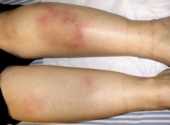Erythema nodosum

IMPORTANT The information provided is of a general nature and should not be used as a substitute for professional advice. If you think you may suffer from an allergic or other disease that requires attention, you should discuss it with your family doctor. The content of the information articles and all illustrations on this website remains the intellectual property of Dr Raymond Mullins and cannot be reproduced without written permission.
Summary
Erythema nodosum is an inflammatory condition affecting the skin. Painful, red and tender lumps appear, most commonly over the lower legs. It's appearance often indicates the presence of another problem, such as infection or drug sensitivity.
Erythema nodosum is an inflammatory condition
Erythema nodosum is an inflammatory condition affecting the skin. Painful, red and tender lumps appear, most commonly over the lower legs (shins), although other parts of the body may be affected. As the lumps progress, they become darker, often look bruised and sometimes peel. Around half of those affected will feel tired or unwell, and may experience fever or sore joints. Erythema nodosum mainly affects young adults, and women more commonly than men.
The appearance of erythema nodosum may indicate another problem
The appearance of erythema nodosum often indicates the presence of another problem, such as infection (Streptococcal bacterial infection of the throat is one of the most common causes), reaction to a medicine (particularly antibiotics or the oral contraceptive pill) or other medical condition (such as sarcoid, an inflammatory condition of unknown cause) or even during pregnancy. Rare causes include inflammatory bowel disease, Behcet's disease and lymphoma. Even herbal remedies like Echinacea have been associated with this condition. For this reason, special tests like blood tests, chest X-ray or even a biopsy of the rash may sometimes be required.
Erythema nodosum is usually transient
Most cases resolve within a few months and rarely return. Long-term complications or scarring are extremely unlikely. The aim of treatment is therefore to keep patients comfortable until symptoms resolve with time.
Management of erythema nodosum
Erythema nodosum is painful and often results in leg swelling. Bed rest, simple painkillers and cold packs may be all that is required. Sometimes, severe pain, fatigue and sore joints demand more aggressive treatment, such as cortisone tablets, potassium iodide or other medications. Such treatments should only be given under the close supervision of your medical practitioner.
References
Ter Poorten MC, Thiers BH. Panniculitis. Dermatol Clin. 2002 Jul;20(3):421-33, vi.
Requena L, Requena C. Erythema nodosum. Dermatol Online J. 2002 Jun;8(1):4.
Bonci A, Di Lernia V, Merli F, Lo Scocco G. Erythema nodosum and Hodgkin's disease. Clin Exp Dermatol. 2001 Jul;26(5):408-11
Barnard J, Newman LS. Sarcoidosis: immunology, rheumatic involvement, and therapeutics. Curr Opin Rheumatol. 2001 Jan;13(1):84-91
Sterling JB, Heymann WR. Potassium iodide in dermatology: a 19th century drug for the 21st century-uses, pharmacology, adverse effects, and contraindications. J Am Acad Dermatol. 2000 Oct;43(4):691-7
Pettersson T. Sarcoid and erythema nodosum arthropathies. Baillieres Best Pract Res Clin Rheumatol. 2000 Sep;14(3):461-76.
Mana J, Marcoval J, Graells J, Salazar A, Peyri J, Pujol R. Cutaneous involvement in sarcoidosis. Relationship to systemic disease. Arch Dermatol. 1997 Jul;133(7):882-8.
Fernandes NC, Maceira J, Muniz Mde M. Erythema nodosum: prospective study of 32 cases. Rev Inst Med Trop Sao Paulo. 1994 Nov-Dec;36(6):507-13.
Last reviewed 29 May 2020

